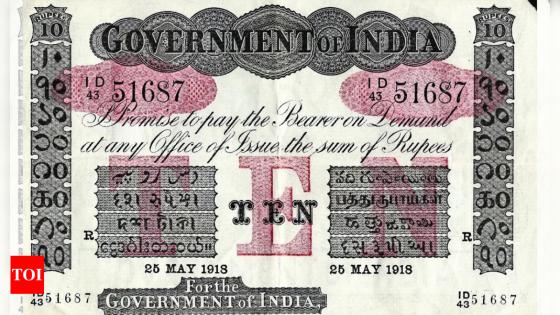On July 2, 1918, towards the end of WW-1, a British ship named ‘SS Shirala‘ sank in the English Channel. Its ‘killer’ was the dreaded German submarine UB-57, commanded by Oberleutnant Johannes Lohs who destroyed dozens of enemy ships with a combined capacity of over 1.5 lakh tonnes before he died aged 29.
The Shirala accounted for just about 4% of Lohs’ kills, but it was destined to make headlines long after death, as it’s doing now.Sometime this afternoon, two Rs 10 notes and a Re 1 note salvaged from its wreck will go under the hammer at British auction house Noonans Mayfair. The Rs 10 notes could fetch up to £2,600 (Rs 2.7 lakh) each.
Floating Vault
The Shirala was a small ship, just 425 feet long and 50 wide. It was launched on Aug 31, 1901, and had gone around the world many times for the British India Steam Navigation Company, carrying everything from biscuits to railway sleepers.
But when it set out on its final journey to Bombay, on July 1, 1918, it was also loaded with precious cargo. Some say there were diamonds on board, others mention elephant tusks. It certainly had plenty of marmalade jars – specifically, Dundee marmalade – for the British in India and spares for their vehicles and weapons. Above all, the Shirala was bringing new currency notes. There were unsigned notes of Rs 5 and Rs 10 denominations, besides signed Re 1 notes. The Re 1 note had been introduced very recently, on Nov 30, 1917. Until then, Rs 5 had been the smallest denomination for notes in India. An article in the International Bank Note Society Journal says Re 1 notes used to come pre-signed from Britain, so when the Shirala sank, it became the “first case of notes lost at sea which were pre-signed before their arrival in India from England”.
Notes Slip Out
The bigger notes were sent unsigned from Britain, and would have become legal tender only after receiving the signatures of officials at the Indian Currency Office. As the Shirala sank in shallow water close to the English coast, bits of its cargo started washing up on the shore. Among them were notes of all three denominations.
In its Feb 6, 1920 edition, The Pioneer Mail of Allahabad reported that “Some of the notes were saved and have recently made their appearance at the Currency Office in Rangoon from local banks.” In some cases, notes from the Shirala were presented with forged signatures. “So far, eight of these notes are in custody of the authorities… All are of Rs 5 denomination,” the paper said.
Treat For Divers
Some of the Shirala’s rupee notes stayed with their finders, which is why, after 106 years, they are up for auction. Meanwhile, the ship’s wreck has become an attraction for divers. Historic England, which looks after British heritage sites, says Shirala’s holds still contain “cases of wine; crates of Dundee marmalade; spares for vehicles …binoculars and telescopes; some ivory…” But what you might not find now, after a century under water, are its rupee notes.
The Shirala accounted for just about 4% of Lohs’ kills, but it was destined to make headlines long after death, as it’s doing now.Sometime this afternoon, two Rs 10 notes and a Re 1 note salvaged from its wreck will go under the hammer at British auction house Noonans Mayfair. The Rs 10 notes could fetch up to £2,600 (Rs 2.7 lakh) each.
Floating Vault
The Shirala was a small ship, just 425 feet long and 50 wide. It was launched on Aug 31, 1901, and had gone around the world many times for the British India Steam Navigation Company, carrying everything from biscuits to railway sleepers.
But when it set out on its final journey to Bombay, on July 1, 1918, it was also loaded with precious cargo. Some say there were diamonds on board, others mention elephant tusks. It certainly had plenty of marmalade jars – specifically, Dundee marmalade – for the British in India and spares for their vehicles and weapons. Above all, the Shirala was bringing new currency notes. There were unsigned notes of Rs 5 and Rs 10 denominations, besides signed Re 1 notes. The Re 1 note had been introduced very recently, on Nov 30, 1917. Until then, Rs 5 had been the smallest denomination for notes in India. An article in the International Bank Note Society Journal says Re 1 notes used to come pre-signed from Britain, so when the Shirala sank, it became the “first case of notes lost at sea which were pre-signed before their arrival in India from England”.
Notes Slip Out
The bigger notes were sent unsigned from Britain, and would have become legal tender only after receiving the signatures of officials at the Indian Currency Office. As the Shirala sank in shallow water close to the English coast, bits of its cargo started washing up on the shore. Among them were notes of all three denominations.
In its Feb 6, 1920 edition, The Pioneer Mail of Allahabad reported that “Some of the notes were saved and have recently made their appearance at the Currency Office in Rangoon from local banks.” In some cases, notes from the Shirala were presented with forged signatures. “So far, eight of these notes are in custody of the authorities… All are of Rs 5 denomination,” the paper said.
Treat For Divers
Some of the Shirala’s rupee notes stayed with their finders, which is why, after 106 years, they are up for auction. Meanwhile, the ship’s wreck has become an attraction for divers. Historic England, which looks after British heritage sites, says Shirala’s holds still contain “cases of wine; crates of Dundee marmalade; spares for vehicles …binoculars and telescopes; some ivory…” But what you might not find now, after a century under water, are its rupee notes.
Source Agencies

